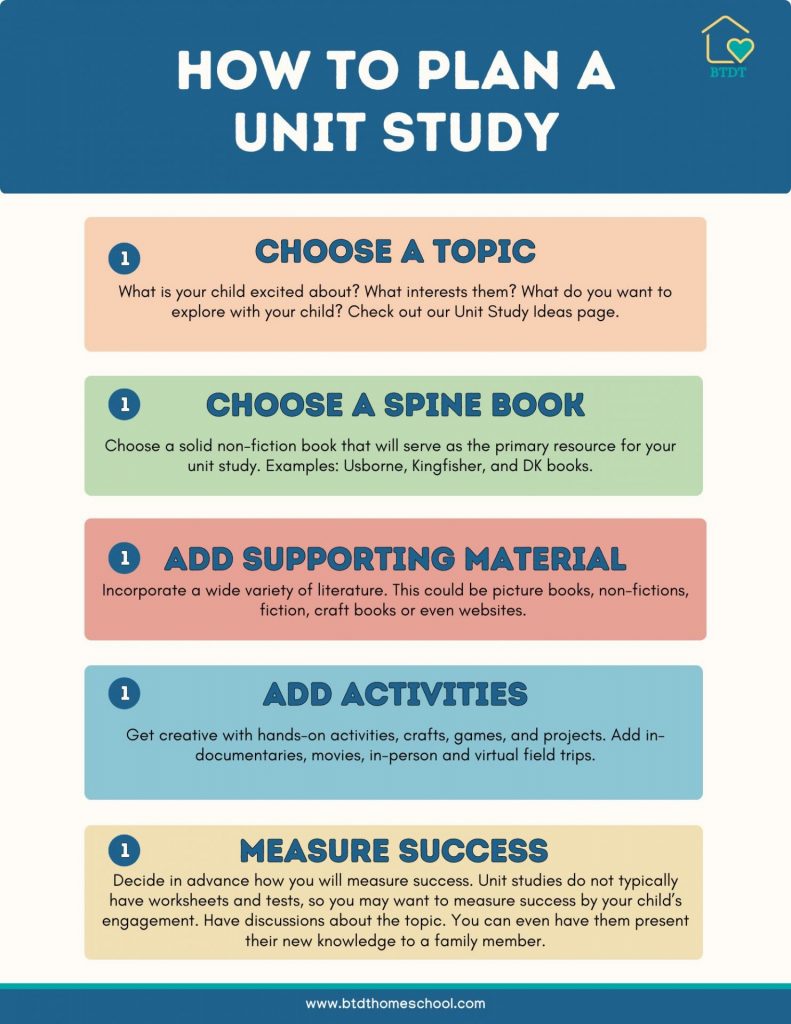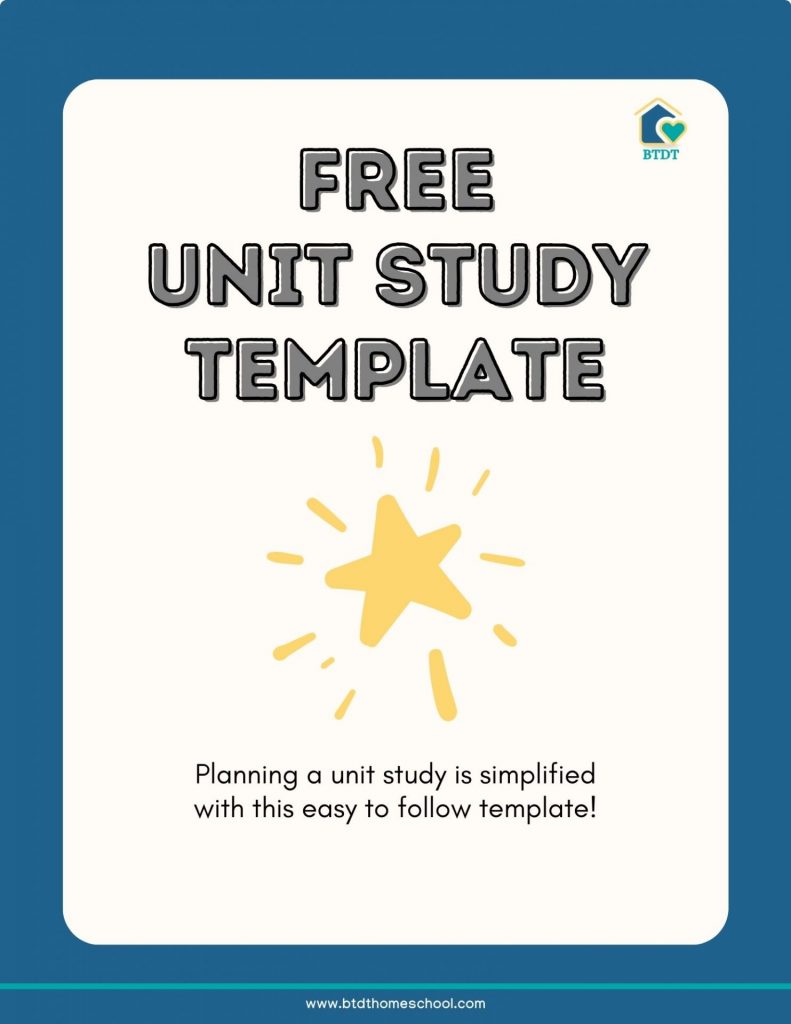How Do You Create a Unit Study?

Unit studies are a great option for homeschoolers. They foster a deeper understanding of a subject by exploring it in detail and encouraging critical thinking. We love all the hands-on, experiential learning opportunities they provide. They also offer a unique way to combine multiple subjects around a central theme, allowing for a more immersive and interconnected learning experience. Learn all about unit studies and how to create your own!
To help kick start your journey, we’ve put together an extensive list of Unit Study Ideas.
Episode 056:
TWO WAYS TO LISTEN TO THIS EPISODE:
1. Click PLAY Button Above ^^ to listen here.
2. OR Listen on your favorite podcast platform:
Scroll down for this week’s FREEBIE:
Unit Study Planner (pdf)
Are you just starting your homeschooling journey? We’re here to help! Begin with our Get Started in Homeschooling page and Homeschooling FAQ to make the transition smoother. If you’re guiding a young child, explore our How to Homeschool Kindergarten. to make those first steps special. For middle schoolers, don’t miss our Middle School page packed with tips and advice. And if you’re heading into the high school years, our Essential Steps to Homeschool High School will guide you every step of the way!
Show Notes
If you’ve chosen to follow a curriculum, sometimes the monotony of it can feel stifling, leaving you and your children disinterested and longing for a more engaging approach to learning. Oftentimes, people will start curriculum hopping, but exploring a unit study might be the refreshing change you’re looking for. Its integrative approach can breathe life into your homeschool as it weaves together various subjects around a central theme.
Unit studies can really be an opportunity to infuse excitement into your day. We love the hands-on engagement that comes with unit studies and how it can really get kids excited about the theme.
Some people even choose to do unit studies as the central core in their homeschool instead of traditional curriculum. There are tons of options. In today’s episode, we are going to talk about unit studies and how to create one for your homeschool.
We have always really enjoyed unit studies and we especially enjoyed them when our kids were younger and they were hyper focused on a certain topic and we would dive in deep and learn everything we could about our chosen theme. We did unit studies on penguins, the light spectrum, music, and so many other themes. Sometimes it’s nice to take a break from the curriculum and jump into a unit study. It always seems to reignite our kids and brings a new and refreshing joy of learning into our home.
One of our favorite ways to incorporate unit studies is during the holiday season. We’ve always found that embracing a unit study during the holidays offers a sense of flexibility, allowing for exploration while still delving into meaningful learning experiences. Everybody is always so busy during the holidays and it’s a great time to abandon the typical curriculum. It also helps to avoid burnout. Susan Wise Bauer once said “Everyone wants to quit in November and February” and seasoned homeschoolers know this is true! Learn more about Homeschooling During the Holidays.
Homeschoolers often gravitate towards unit studies due to their holistic and integrative approach to education. They offer a unique way to combine multiple subjects around a central theme, allowing for a more immersive and interconnected learning experience. This method of learning aligns with the personalized nature of homeschooling, enabling parents to tailor education to their child’s pace, interests, and learning style. It fosters a deeper understanding of a subject by exploring it from various angles. It also encourages critical thinking, and provides hands-on, experiential learning opportunities.
You can generally make unit studies multi-age, which promotes family involvement. This is one of my favorite things about unit studies, everybody’s learning the same thing – maybe just at different levels or depth. This approach tends to nurture a rich and engaging learning environment that goes beyond traditional textbooks and classroom settings.
What is a unit study? (7:33)
A homeschool unit study is an interdisciplinary approach to learning that revolves around a specific theme or topic. It encourages students to explore and understand a subject deeply by incorporating multiple subjects and various activities into a comprehensive study plan.
Let’s break down the key features of a homeschool unit study:
Theme-Centered:
Unit studies focus on a central theme or topic, it could be as simple as an animal like penguins or a broader topic like birds. It could be a historical event or historical period, it could be a scientific concept, a piece of literature, or even a specific country, or geographic location. There’s really endless options for these!

Emphasis on Student Interests:
Homeschool unit studies can be tailored to a student’s interests which helps to foster a love for learning. Is your kid obsessed with dinosaurs, or cars, or a time period or country? Try a unit study!
Integration of Subjects:
They integrate multiple subjects like math, science, history, language arts, and art around the chosen theme. This fosters a holistic understanding of the topic. This also can be a huge time saver if you have multi-age kids, or are trying to fit a lot of subjects into your day. You can meet with all the kids to read aloud, and then break off for age appropriate activities.
Multi-Sensory Learning:
They incorporate various learning methods, such as reading, writing, experiments, field trips, art projects, and discussions, to cater to different learning styles. Unit studies often emphasize real-life applications and hands-on activities to make learning more engaging and practical.
Flexible and Customizable:
Homeschoolers can customize unit studies to suit their child’s interests and learning style, which allows for flexibility in curriculum design. They encourage students to explore a subject in depth. This promotes critical thinking and a deeper understanding of the topic. Many find that choosing a main book or resource as a “spine” is helpful where they reference back to throughout the unit. You can incorporate field trips, projects, documentaries and movies, and fun games all around your central theme.
Here are some examples of our favorite “spine” books:
- Usborne Encyclopedia books
- Smithsonian books
- The Kingfisher History Encyclopedia books
- DK Series books
- National Geographic books
Unit studies are a popular approach in homeschooling because they provide a flexible and immersive way to learn, allowing students to delve deeply into topics of personal interest while covering core academic subjects.
What are some ideas for great unit studies? (11:11)
The topics for unit studies are really endless. You can make one about anything you want. Here are a few examples of unit study ideas that can be adapted and expanded upon:
- Ancient Egypt: Cover history by exploring pharaohs, pyramids, and daily life. Integrate art by creating hieroglyphics or Egyptian art pieces, study geography by examining the Nile River, delve into mythology and religion, and even incorporate science by studying the mummification processes. Ancient Egypt Projects
- Weather: Explore meteorology, covering science through understanding weather patterns, math through data analysis, geography by studying climates around the world, and language arts through weather-related literature or writing weather reports. We used a Williamson kids book as our base for this. Weather Projects
- Animals and Habitats: Dive into biology by studying specific animals and their habitats, incorporate geography by mapping out where these animals live, explore environmental science by discussing conservation efforts, and integrate art by creating representations of various habitats. This Visual Animal Encyclopedia is perfect for a unit study!
- Inventors and Inventions: Connect history by studying key inventors and their impact, science through understanding the principles behind inventions, math by calculating measurements or timelines, and language arts through biographical writing or reading invention-related literature. “Nikola Tesla for Kids: His Life, Ideas, and Inventions, with 21 Activities” is an awesome resource you can use for a unit study. Incorporating “Black Inventors: 15 Inventions that Changed the World” is a great addition to include diverse contributions. “Hooray For Inventors!” is a wonderful resource to open up discussions about a wide variety of inventions.
- Space Exploration: Cover science by studying planets and space travel, history through the space race and key astronauts, math by calculating distances or sizes of celestial bodies, language arts through writing about space exploration or reading related literature, you can watch a space documentary or movie like hidden figures, you can design, build, and launch rockets, you can incorporate art by creating space-themed projects. Get your Free Celestial Hike activity! Another great resource for a space unit study is, “Astronomy Activity Book for Kids: 100+ Fun Ways to Learn About Space and Stargazing”.
- Cultural Diversity: Integrate social studies by exploring different cultures and their traditions, geography by studying various countries and their customs, language arts through reading multicultural literature, and art by creating crafts or artworks inspired by different cultures. Learn more about Cultural Study in your Homeschool. This is basically what our Geography club did for years!
- Civil Rights Movement: Connect history by studying key events and figures. You can incorporate social studies by discussing equality and social justice. Language arts can be covered through reading or listening to speeches or reading memoirs of influential leaders, Art can be taught by learning about powerful art created during that time or creating projects that represent the movement. “Timelines from Black History: Leaders, Legends, Legacies” introduces children to prominent Black people in history such as Frederick Douglass, Harriet Tubman, Nelson Mandela, Rosa Parks, and Dr. Martin Luther King. “The Civil Rights Movement for Kids: A History with 21 Activities” is a great place to find resources for a unit study. Also, check out the PBS collection of Civil Rights Videos, Lesson Plans, and more.
These are just starting points; each unit study can be adapted, expanded, or combined with other subjects to suit the interests and educational needs of the child. The flexibility of homeschooling allows for endless possibilities in designing unit studies. See the Complete List of Unit Study Ideas
How do I create my own unit study? (22:09)

Creating a homeschool unit study can be a fantastic way to integrate various subjects around a central theme or topic. Our free resource for the week is a template to help you develop your own unit study. So to get you started, here are 7 steps to help you develop one:
1. Choose a Theme or Topic
Select a broad theme or specific topic that can encompass multiple subjects.
2. Identify Learning Objectives
Determine what you want your child to learn or achieve through this unit study. Define specific learning objectives for each subject area you’ll cover.
3. Gather Resources
Collect books, online resources, documentaries, experiments, worksheets, and other materials related to your chosen theme. Libraries, educational websites, and museums can be excellent sources. For me this often means going through my house to see what stuff I already have!
Your spine book will be your main go-to when you start working through your unit study. Within it, you’ll be able to find topics or rabbit holes to meander down. Here are some examples of spine books:
- Usborne Encyclopedia books
- Smithsonian books
- The Kingfisher History Encyclopedia books
- DK Series books
- National Geographic books
4. Create Lesson Plans
Develop a schedule or outline for your unit study. Plan activities, readings, experiments, and projects for each day or week. Be flexible and adapt as needed.
5. Integrate Subjects
Find ways to connect different subjects within the theme. For instance, if you’re studying the medieval time period, a math lesson could involve the Sir Cumference books, a language arts lesson might involve reading about King Arthur, and watching the show “Merlin.”
6. Hands-On Activities
Include hands-on experiences. This is my favorite part! Put some thought into this. Are there science experiments, art projects, field trips, or interviews with experts related to the theme that can make learning about your theme more engaging? I remember when we did our entire school year unit study of American music. We had tons of activities during this unit I put together and every four weeks, I had a major project. We built a transistor radio, we made a mixtape, we wrote a song and performed it. And this was in addition to all the other fun, hands-on activities. I made him build a guitar for the final school year-end project.

7. Adapt to Your Child’s Pace
Be flexible and adapt to your child’s learning pace and style. If they show interest in a particular aspect, delve deeper into it. Foster a spirit of curiosity and exploration. Encourage your child to ask questions, seek answers, and explore beyond the boundaries of the set curriculum.
Periodically assess the effectiveness of your unit study. Consider what worked well and what could be improved. Adjust the plan accordingly for future studies. Remember, the beauty of homeschooling is the flexibility it offers. Don’t hesitate to modify the plan as needed based on your child’s interests, strengths, and areas that might need more attention.
What if I don’t want to do it on my own? Where can I find homeschool unit studies?
There are several resources available for secular homeschool unit studies. Here are five that provide a variety of subjects and approaches:
- Build Your Library: This is a literature-based curriculum that offers secular unit studies covering various subjects. It often integrates history, science, language arts, and more around engaging literature. We’ve done their Evolution and Darwin unit study and she had a great one on Government and Elections.
- Blossom and Root: This curriculum is designed with a secular, nature-based approach. It offers unit studies across different subjects, focusing on nature, literature, and art.
- Teachers Pay Teachers: provides eclectic, literature-rich unit studies for a range of ages and subjects, with an emphasis on making learning engaging and multi-dimensional.
- Torchlight Curriculum: Torchlight offers unit studies based on engaging literature, history, and science for multiple grade levels, incorporating a secular approach.
- Curiosity Chronicles: This resource offers unit studies that combine history, literature, and geography, providing secular materials suitable for homeschoolers.
More unit study resources available here: Secular unit study Facebook group
These sources often provide comprehensive unit study packages or guides that cover multiple subjects, allowing for an integrated approach to learning while catering to secular preferences. It’s always a good idea to review samples or trial periods to ensure the resources align with your homeschooling goals and your child’s learning style. This is also often a good way to try out a particular curriculum.
If you’ve never thought about unit studies, you may want to consider buying or building your own. This might be just the thing you’re looking for to engage your child or if you’re feeling a little burned out and looking for a refreshing change from your regular curriculum.
This Week’s Freebie:







